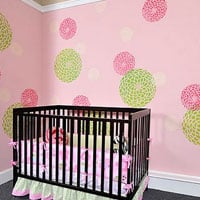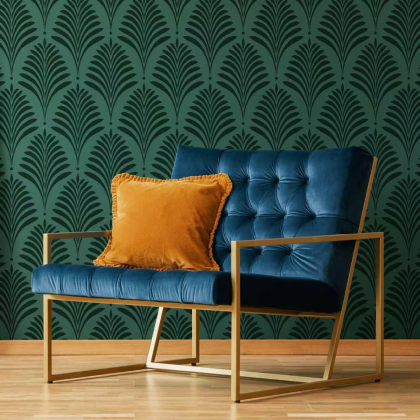Video Tutorial: How To Stencil Using an Interlocking Pattern
Video How-To Helps Stencil a Feature Wall with Interlocking Pattern

Stenciling an interlocking pattern can be a bit confusing. So to help out,
Cutting Edge Stencils has put together a quick how-to video that explains the process rather well (in our opinions)! The key to any interlocking pattern is to figure out which parts of the
stencils line up together (or interlock) before you begin painting! It might be a good idea, if you are a
first time stenciler, to stencil a piece of cardboard or something disposable first to make sure you have the hang of it prior to painting your walls. This tutorial will be sure to help you better understand the process of painting interlocking patterns, though, so no worries DIYers! Watch the video below!
Here's What You'll Need:

Cutting Edge Stencils' Interlocking stencil pattern (
Simple Rhyme used here)
Clip on stencil level
Benjamin Moore paint
Dense foam roller
Paper towels
Stencil brush
Foam plate
Painters tape
Here's What You Do:
First position your stencil on the wall, and adhere it with a small piece of blue painters tape on each corner. To make sure the pattern is straight, check your clip on level, which should be securely fashioned to the bottom of your stencil design.
Pour your paint onto the foam plate and load your dense foam roller. Then offload the paint onto a paper towel by rolling it back and forth until the roller seems almost dry and the paint is evenly distributed.
Start stenciling your wall using light to medium pressure on your dense foam roller. Pressing too hard will lead to bleeding and smudging.
Remove the stencil from the wall slowly as to not rip off your background paint.
Realign the stencil (vertically) so that the topmost section of the Simple Rhyme stencil locks in with the bottommost section of the pattern you've already painted on your wall. Check your level again, and continue the stenciling process.

You may want to avoid repainting over the interlocking part of the pattern. Two coats of paint will make that one portion noticeably darker in than the rest of the pattern. (Notice Janna starts painting her second design directly under the interlocking section.)
Once you've finished your first column of pattern, realign your stencil directly to the right of the topmost pattern. You will be able to line it up using the registration marks on the side of the pattern you have already completed. You may want to reload your roller with paint before you start stenciling the next section.

After completing that pattern and removing the stencil from the wall, realign the stencil to be underneath the last painted section. The side and top portions of the stencil should lock in with the patterns that have already been painted on the wall. Then repeat this process until your entire wall is covered in the Simple Rhyme pattern.

In order to finish the edges (ie. the corner where the wall meets the floor), roll your roller straight into the crease. Then use your stencil brush to complete the portions of the design that can't be reached with your roller. Tip: Make sure to use little paint on your stencil brush by offloading the paint onto a paper towel before stenciling with it.
To complete the design all the way up to the ceiling, use the top part stencil provided with the Simple Rhyme design. Use your brush with this stencil in order to get your paint into the corners! Remove the stencil and VOILA!

"Cutting Edge Stencils and Benjamin Moore paint is beautiful made easy!"
For more on stencils:
Thanks for watching and reading! Happy stenciling, DIYers!
Melissa and the Cutting Edge Stencils Crew
 Stenciling an interlocking pattern can be a bit confusing. So to help out, Cutting Edge Stencils has put together a quick how-to video that explains the process rather well (in our opinions)! The key to any interlocking pattern is to figure out which parts of the stencils line up together (or interlock) before you begin painting! It might be a good idea, if you are a first time stenciler, to stencil a piece of cardboard or something disposable first to make sure you have the hang of it prior to painting your walls. This tutorial will be sure to help you better understand the process of painting interlocking patterns, though, so no worries DIYers! Watch the video below!
Stenciling an interlocking pattern can be a bit confusing. So to help out, Cutting Edge Stencils has put together a quick how-to video that explains the process rather well (in our opinions)! The key to any interlocking pattern is to figure out which parts of the stencils line up together (or interlock) before you begin painting! It might be a good idea, if you are a first time stenciler, to stencil a piece of cardboard or something disposable first to make sure you have the hang of it prior to painting your walls. This tutorial will be sure to help you better understand the process of painting interlocking patterns, though, so no worries DIYers! Watch the video below!
 Cutting Edge Stencils' Interlocking stencil pattern (Simple Rhyme used here)
Clip on stencil level
Benjamin Moore paint
Dense foam roller
Paper towels
Stencil brush
Foam plate
Painters tape
Cutting Edge Stencils' Interlocking stencil pattern (Simple Rhyme used here)
Clip on stencil level
Benjamin Moore paint
Dense foam roller
Paper towels
Stencil brush
Foam plate
Painters tape
 You may want to avoid repainting over the interlocking part of the pattern. Two coats of paint will make that one portion noticeably darker in than the rest of the pattern. (Notice Janna starts painting her second design directly under the interlocking section.)
Once you've finished your first column of pattern, realign your stencil directly to the right of the topmost pattern. You will be able to line it up using the registration marks on the side of the pattern you have already completed. You may want to reload your roller with paint before you start stenciling the next section.
You may want to avoid repainting over the interlocking part of the pattern. Two coats of paint will make that one portion noticeably darker in than the rest of the pattern. (Notice Janna starts painting her second design directly under the interlocking section.)
Once you've finished your first column of pattern, realign your stencil directly to the right of the topmost pattern. You will be able to line it up using the registration marks on the side of the pattern you have already completed. You may want to reload your roller with paint before you start stenciling the next section.
 After completing that pattern and removing the stencil from the wall, realign the stencil to be underneath the last painted section. The side and top portions of the stencil should lock in with the patterns that have already been painted on the wall. Then repeat this process until your entire wall is covered in the Simple Rhyme pattern.
After completing that pattern and removing the stencil from the wall, realign the stencil to be underneath the last painted section. The side and top portions of the stencil should lock in with the patterns that have already been painted on the wall. Then repeat this process until your entire wall is covered in the Simple Rhyme pattern.
 In order to finish the edges (ie. the corner where the wall meets the floor), roll your roller straight into the crease. Then use your stencil brush to complete the portions of the design that can't be reached with your roller. Tip: Make sure to use little paint on your stencil brush by offloading the paint onto a paper towel before stenciling with it.
To complete the design all the way up to the ceiling, use the top part stencil provided with the Simple Rhyme design. Use your brush with this stencil in order to get your paint into the corners! Remove the stencil and VOILA!
In order to finish the edges (ie. the corner where the wall meets the floor), roll your roller straight into the crease. Then use your stencil brush to complete the portions of the design that can't be reached with your roller. Tip: Make sure to use little paint on your stencil brush by offloading the paint onto a paper towel before stenciling with it.
To complete the design all the way up to the ceiling, use the top part stencil provided with the Simple Rhyme design. Use your brush with this stencil in order to get your paint into the corners! Remove the stencil and VOILA!
 "Cutting Edge Stencils and Benjamin Moore paint is beautiful made easy!"
For more on stencils:
"Cutting Edge Stencils and Benjamin Moore paint is beautiful made easy!"
For more on stencils:







